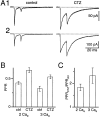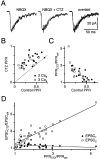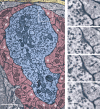Ultrastructural contributions to desensitization at cerebellar mossy fiber to granule cell synapses
- PMID: 12657677
- PMCID: PMC6742013
- DOI: 10.1523/JNEUROSCI.23-06-02182.2003
Ultrastructural contributions to desensitization at cerebellar mossy fiber to granule cell synapses
Abstract
Postsynaptic AMPA receptor desensitization leads to depression at some synapses. Here we examine whether desensitization occurs at mossy fiber to granule cell synapses and how synaptic architecture could contribute. We made whole-cell voltage-clamp recordings from granule cells in rat cerebellar slices at 34 degrees C, and stimulated mossy fibers with paired pulses. The amplitude of the second EPSC was depressed by 60% at 10 msec and recovered with tau approximately 30 msec. This fast component of recovery from depression was reduced by cyclothiazide and enhanced when release probability was increased, suggesting that it reflects postsynaptic receptor desensitization. We evaluated the importance of synaptic ultrastructure to spillover and desensitization by using serial electron microscopy to reconstruct mossy fiber glomeruli. We found that mossy fiber boutons had hundreds of release sites, that the average center-to-center distance between nearest release sites was 0.46 microm, and that these sites had an average of 7.1 neighbors within 1 microm. In addition, glia did not isolate release sites from each other. By contrast, desensitization plays no role in paired-pulse depression at the cerebellar climbing fiber, where glial ensheathment of synapses is nearly complete. This suggests that the architecture of the mossy fiber glomerulus can lead to desensitization and short-term depression. Modeling indicates that, as a consequence of the close spacing of release sites, glutamate released from a single site can desensitize AMPA receptors at neighboring sites, even when the probability of release (p(r)) is low. When p(r) is high, desensitization would be accentuated by such factors as glutamate pooling.
Figures








Similar articles
-
Prolonged physiological entrapment of glutamate in the synaptic cleft of cerebellar unipolar brush cells.J Neurophysiol. 1997 Sep;78(3):1320-33. doi: 10.1152/jn.1997.78.3.1320. J Neurophysiol. 1997. PMID: 9310423
-
Properties of transmission at a giant glutamatergic synapse in cerebellum: the mossy fiber-unipolar brush cell synapse.J Neurophysiol. 1995 Jul;74(1):24-42. doi: 10.1152/jn.1995.74.1.24. J Neurophysiol. 1995. PMID: 7472327
-
Short-term synaptic plasticity during development of rat mossy fibre to granule cell synapses.Eur J Neurosci. 2005 Apr;21(8):2149-58. doi: 10.1111/j.1460-9568.2005.04048.x. Eur J Neurosci. 2005. PMID: 15869511
-
Helping thy neighbors: spillover at the mossy fiber glomerulus.Neuron. 2002 Aug 1;35(3):412-4. doi: 10.1016/s0896-6273(02)00796-1. Neuron. 2002. PMID: 12165464 Review.
-
The Cerebellar Mossy Fiber Synapse as a Model for High-Frequency Transmission in the Mammalian CNS.Trends Neurosci. 2016 Nov;39(11):722-737. doi: 10.1016/j.tins.2016.09.006. Epub 2016 Oct 19. Trends Neurosci. 2016. PMID: 27771145 Review.
Cited by
-
High-concentration rapid transients of glutamate mediate neural-glial communication via ectopic release.J Neurosci. 2005 Aug 17;25(33):7538-47. doi: 10.1523/JNEUROSCI.1927-05.2005. J Neurosci. 2005. PMID: 16107641 Free PMC article.
-
Desensitization properties of AMPA receptors at the cerebellar mossy fiber granule cell synapse.J Neurosci. 2007 Aug 1;27(31):8344-57. doi: 10.1523/JNEUROSCI.2399-07.2007. J Neurosci. 2007. PMID: 17670981 Free PMC article.
-
Timing and location of synaptic inputs determine modes of subthreshold integration in striatal medium spiny neurons.J Neurosci. 2007 Aug 15;27(33):8967-77. doi: 10.1523/JNEUROSCI.2798-07.2007. J Neurosci. 2007. PMID: 17699678 Free PMC article.
-
A variant of Nesprin1 giant devoid of KASH domain underlies the molecular etiology of autosomal recessive cerebellar ataxia type I.Neurobiol Dis. 2015 Jun;78:57-67. doi: 10.1016/j.nbd.2015.03.027. Epub 2015 Apr 2. Neurobiol Dis. 2015. PMID: 25843669 Free PMC article.
-
Dietary Supplementation of Hericium erinaceus Increases Mossy Fiber-CA3 Hippocampal Neurotransmission and Recognition Memory in Wild-Type Mice.Evid Based Complement Alternat Med. 2017;2017:3864340. doi: 10.1155/2017/3864340. Epub 2017 Jan 1. Evid Based Complement Alternat Med. 2017. PMID: 28115973 Free PMC article.
References
-
- Auger C, Attwell D. Fast removal of synaptic glutamate by postsynaptic transporters. Neuron. 2000;28:547–558. - PubMed
-
- Burger PM, Mehl E, Cameron PL, Maycox PR, Baumert M, Lottspeich F, De Camilli P, Jahn R. Synaptic vesicles immunoisolated from rat cerebral cortex contain high levels of glutamate. Neuron. 1989;3:715–720. - PubMed
-
- Chaudhry FA, Lehre KP, van Lookeren Campagne M, Ottersen OP, Danbolt NC, Storm-Mathisen J. Glutamate transporters in glial plasma membranes: highly differentiated localizations revealed by quantitative ultrastructural immunocytochemistry. Neuron. 1995;15:711–720. - PubMed
-
- Chen C, Blitz DM, Regehr WG. Contributions of receptor desensitization and saturation to plasticity at the retinogeniculate synapse. Neuron. 2002;33:779–788. - PubMed
-
- Crank J. The mathematics of diffusion. Clarendon; Oxford: 1975.
Publication types
MeSH terms
Substances
Grants and funding
LinkOut - more resources
Full Text Sources
Research Materials
